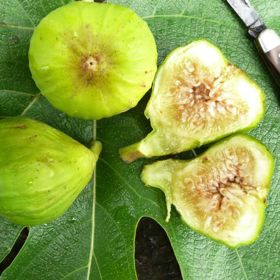Lattarula Fig Tree
Description
A true Italian Honey Fig, that is sweet and delectable. One of the most popular figs planted in the Northwest. You’ll never get enough of these figs as they can bear two crops in one season – one ripening in July and the second in mid-September. Plus, the compact growth habit makes this fig perfect for container gardening.
Overwintering Fig Trees in Cooler Climates
If you experience temperatures below freezing, then additional winter protection is necessary for best results.
Potted figs should be placed in an insulated, unheated, preferably dark room or cool basement. Water them monthly until just moist so the roots do not dry out completely.
For fig trees planted in-ground, insulate as much as possible by getting creative. Use chicken wire and burlap or surround with straw bales stuffed with leaves. The pliable branches can be bent in to preserve as much as the plant as possible. What is not covered, will likely die back. Figs fruit on new growth and the insulated roots will send out new growth, even if the top dies.
Characteristics
| Fruit Color | Yellow Green |
| Fruit Size | Medium |
| Hardiness Zone Range | 2 - 10, Outdoor Planting: 7 - 10 |
| Pollination | Self-Pollinating |
| Ripens/Harvest | July/september |
| Shade/Sun | Full Sun |
| Soil Composition | Loamy |
| Soil Moisture | Well Drained |
| Soil pH Level | 6.0 - 6.5 |
| Taste | Sweet |
| Texture | Soft |
| Years to Bear | 2 - 3 |
Zone Compatibility
Pollination
This variety is self pollinating.
Tools & Supplies
Planting & Care
Learn all about how to grow fig trees in The Growing Guide. An entire section of our website dedicated to your growing success.





